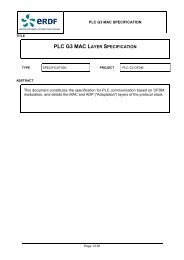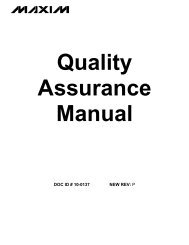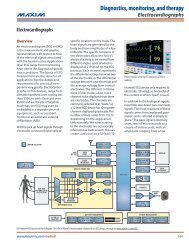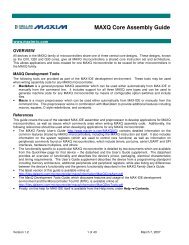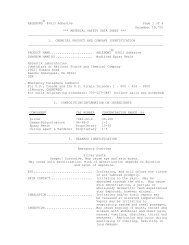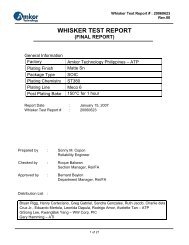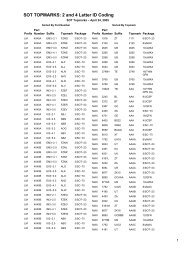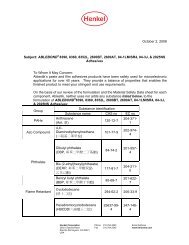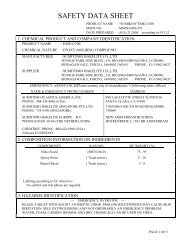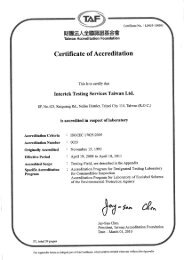Smart Grid Solutions Guide - Maxim
Smart Grid Solutions Guide - Maxim
Smart Grid Solutions Guide - Maxim
Create successful ePaper yourself
Turn your PDF publications into a flip-book with our unique Google optimized e-Paper software.
<strong>Smart</strong> metersOverviewby using higher end functionality forantitampering purposes).There is long-term potential for costsavings by combining the AMRfunctions directly into themetrology SoC. Yet, this is unlikely tobe practical in the near term, dueprimarily to fragmentation of AMRcommunications methodologies.Communication links may be basedon modems (either fixed line orcellular wireless) or powerlinecommunications (PLC), with the BOMcost ranging from $3 for PLC up tomore than $20 for cellular modems.Field programmabilityDeploying higher end metrologychips that allow for field programmability(via firmware) enables utilitiesto bring down both operational andcapital investment costs over thelong term. This extends the useful lifeof the infrastructure and helps tojustify smart metering investmentswithin rate-based calculations.Field programmability gives utilitiesmuch greater flexibility to adjustpolicies in response to changingenergy usage patterns. For example,the specific times of day set forpeak-rate pricing policies may needto be adjusted as significant numbersof users shift their energy consumption,or in response to seasonalfluctuations. Remote upgrades viafirmware allow utilities to quicklytailor their rate incentives forcustomers to help smooth out peakdemand while tracking dynamicchanges in peak-usage patterns.Energy-management services<strong>Smart</strong> metering gives utilities realtimevisibility into usage patterns.Moreoever, it enables them topromote demand-side management,empowering customers to bettermanage their own usage. Forinstance, the Californian utility PG&Eplans to offer customers enhancedoptions such as monitoring theirhour-by-hour usage on the Internetand adjusting their usage to takeadvantage of incentive rates. Inaddition, there are plans for enablingwireless integration of smart meterswith customers’ thermostats. Thiswill allow minor pre-agreed adjustmentsto automatically be made totemperature settings during peakperiods in exchange for an overallrate reduction.<strong>Smart</strong> metering also opens up thepossibilities for implementing submeteringstrategies within largerbuildings. By using a single smartmeter with multidrop communicationlinks to individual customers,a utility can eliminate the need forindividual meters while still providinga high degree of visibility into eachcustomer’s energy usage.Security mechanismsAntitampering is another key driverfor smart metering, especially indeveloping countries where electricitytheft is a major cost concern forutilities. For example, it has beenestimated that as much as 40 percentof the power usage in Brazil is stolen.Typical tampering techniquesvary from intrusive means suchas breaking the meter housingand jamming the mechanism tomore subtle methods like applyingmagnets to the outside of the meterto saturate magnetic components.Some attempt to alter the characteristicsof the load by addingcapacitance, half-wave rectifiedloads, or instantaneous highcurrents. Others may bypass themeter, wholly or in part, which cancause an increase in the AC currentflowing through the meter’s neutralterminals.Deployment of more sophisticatedsolid-state metrology enablesadvanced antitampering measurementssuch as the reflected load(VAR-hours), neutral current, DCcurrents invoked by rectified loads,and detection of ambient magneticfields. Substation meters may alsobe used to detect discrepanciesbetween the total billed and thetotal generated power and reportthem via an AMR network. In orderto prosecute and recover the costs ofstolen energy, detailed informationsuch as the exact times and amountsof energy theft are critical piecesof evidence that can be capturedthrough smart metering technology.Chip-level feature requirementsfor smart metersSystem on chipIt is clear from the evolving marketrequirements, jurisdictional regulatorydifferences, and varyingimplementation approaches thata single, universal solution is notpossible. However, by using highlyintegrated, flexibly configurable SoCmetering solutions manufacturerscan bring down their R&D costs andimprove their ability to serve theentire range of market requirements.This approach also helps futureproofmeter architectures to meetemerging requirements.Key ingredients of smart meterSoCs include:• Flexible, multiple-port communicationsoptions to support AMRlinks, integration with localdevices such as thermostats,and multidrop submeteringtopologies• Streamlined multiread processingcapabilities such as the SingleConverter Technology approach toreduce unit cost by multiplexinginputs through a delta-sigma ADCin conjunction with a programmablecompute engine• Support for a variety of sensorinputs with minimum hardware;ability to adjust for temperatureand other environmental variationsfor improved efficiency and accuracywww.maxim-ic.com/smartgrid 5




